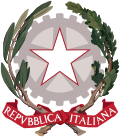Portal:Heraldry
Welcome to the Heraldry and Vexillology Portal!


Vexillology (from the Latin vexillum, a flag or banner) is the scholarly study of flags, including the creation and development of a body of knowledge about flags of all types, their forms and functions, and of scientific theories and principles based on that knowledge. Flags were originally used to assist military coordination on the battlefield, and have evolved into a general tool for signalling and identification, particularly identification of countries.
Heraldry encompasses all of the duties of a herald, including the science and art of designing, displaying, describing and recording coats of arms and badges, as well as the formal ceremonies and laws that regulate the use and inheritance of arms. The origins of heraldry lie in the medieval need to distinguish participants in battles or jousts, whose faces were hidden by steel helmets.
Selected coat of arms

The emblem of Italy (Italian: emblema della Repubblica italiana) was adopted by the newly formed Italian Republic on 5 May 1948. Although often referred to as a coat of arms (or stemma in Italian), it is technically an emblem as it was not designed to conform to traditional heraldic rules. The emblem comprises a white five-pointed star, with a fine red border, superimposed upon a five-spoked cogwheel, standing between an olive branch to the dexter side and an oak branch to the sinister side; the branches are in turn bound together by a red ribbon with the inscription REPVBBLICA ITALIANA. The emblem is used extensively by the Italian government. The armorial bearings of the House of Savoy, blazoned gules a cross argent, were previously in use by the late Kingdom of Italy; the supporters, on either side a lion rampant Or, were replaced with fasci littori (literally bundles of the lictors) during the fascist era. (more...)
Selected flag

The Flag of Europe is the flag and emblem of the European Union (EU) and Council of Europe (CoE) (it is also used to indicate the euro or eurozone countries). It consists of a circle of 12 golden (yellow) stars on a blue background. The blue represents the west; the number of stars represents completeness while their position in a circle represents unity. The stars do not vary according to the members of either organisation as they are intended to represent all the peoples of Europe, even those outside European integration.
The flag was designed by Arsène Heitz and Paul Lévy in 1955 for the CoE as its symbol, and the CoE urged it to be adopted by other organisations. In 1985 the EU, which was then the European Economic Community (EEC), adopted it as its own flag (having had no flag of its own before) at the initiative of the European Parliament. The flag is not mentioned in the EU's treaties, its incorporation being dropped along with the European Constitution, but it is formally adopted in law. (more...)
Selected article

Swedish heraldry refers to the cultural tradition and style of heraldic achievements in modern and historic Sweden. It belongs culturally to the German-Nordic heraldic tradition, noted for its multiple helmets and crests which are treated as inseparable from the shield, repetition of colours and charges between the shield and the crest, and its scant use of heraldic furs. Swedish heraldry is similar to Danish heraldry; both were heavily influenced by German heraldry. The medieval history of the Nordic countries was closely related, so they developed their heraldic individuality rather late. Swedish and Finnish heraldry have a shared history prior to the Diet of Porvoo in 1809. Unlike the macaronic and highly stylized English blazon, Swedish heraldry is described in plain language, using only Swedish terminology.
In Sweden today, the official coats of arms of corporations and government offices are protected by Swedish law, if the coat of arms is registered with the Swedish Patent and Registration Office. Heraldic arms of common citizens (burgher arms), however, are less strictly controlled; these are recognised by inclusion in the annually published Scandinavian Roll of Arms. (more...)
Selected picture

The blue and white banner of Zürich was depicted in a 1585 painting by Humbert Mareschet. The red Schwenkel on top of the banner is typical of German heraldry.
Did you know...
- ...that during the Indonesian National Revolution the first Indonesian flag, Bendera Pusaka (first hoisting pictured), was cut in half to save it from the Dutch military forces?
- ...that Yusak Pakage was sentenced to ten years in prison after raising the Morning Star flag?
- ...that the horseman depicted on the coat of arms of Moscow was not identified with Saint George until the 18th century?
- ...that the flags hoisted by the Finnish icebreaker Tarmo on 3 March 1918 included a large white tablecloth?
- ...that the Alphyn, a rare heraldic creature, was the badge of the Barons de La Warr?
Related portals
|
|
|
Heraldry Web resources
Authorities
- Belgium - The Council of Nobility, Flemish Heraldic Council and Council of Heraldry and Vexillology of the French Community
- Canada - Canadian Heraldic Authority and see also Public Register of Arms, Flags and Badges
- England, Wales, and Northern Ireland - The College of Arms
- Ireland - The Office of the Chief Herald of Ireland
- Netherlands - High Council of Nobility
- Portugal - Instituto da Nobreza Portuguesa
- Scotland - The Court of the Lord Lyon
- South Africa - South African Bureau of Heraldry
- Sweden - National Board of Heraldry, The National Archive
- United States Army - The United States Army Institute of Heraldry
Societies
- Greek Heraldry Society
- The Academy of Heraldic Science Czech republic
- The American College of Heraldry
- The American Heraldry Society
- The Augustan Society
- The Australian Heraldry Society Inc.
- Bulgarian Heraldry and Vexillology Society
- The Center for Research of Orthodox Monarchism
- Cambridge University Heraldic and Genealogical Society
- Chiltern Heraldry Group
- The College of Dracology
- Croatian Heraldic and Vexillologic Association
- The Finnish Heraldic Society
- Fryske Rie foar Heraldyk
- Hellenic Armigers Society
- Guild of Heraldic Artists
- Genealogical Society of Ireland
- Heraldry Research Institute (Japan)
- The Heraldry Society
- The Heraldry Society of Africa
- The Heraldry Society of New Zealand Inc.
- The Heraldry Society of Scotland
- The Heraldry Society of Southern Africa
- The Institute of Heraldic and Genealogical Studies
- The International Association of Amateur Heralds
- Italian Center of Vexillological Studies
- Lancashire Heraldry Group
- Macedonian Heraldry Society
- New England Historic Genealogical Society Committee on Heraldry
- Norwegian Heraldry Society
- Oxford University Heraldry Society
- Polish Heraldry Society
- Polish Nobility Confederation
- Real Academia Matritense de Heráldica y Genealogía - Royal Academy of Heraldry and Genealogy of Madrid
- Romanian Institute for Genealogy and Heraldry
- The Royal Heraldry Society of Canada
- The Russian College of HeraldryThe Russian College of Heraldry
- Serbian Heraldic Society
- Societas Heraldica Scandinavica
- Societas Heraldica Slovenica
- Swedish Heraldic Society
- Ukrainian Heraldry Society
- Royal Association Genealogical and Heraldic Office of Belgium
Vexillology
Software
- Coat of Arms Visual Designer web-based program
- Puncher Heraldry Program
- Blazonry Server - pyBlazon
- DrawShield - creates SVG shield or arms image from blazon
- CoaMaker - web-based tool
- Blazon95 and BLAZONS! 2000, older Windows applications
Texts
- Heraldry, historical and popular : with seven hundred illustrations (1863)
- A Complete Guide to Heraldry (1909)
Other
Wikimedia
The following Wikimedia Foundation sister projects provide more on this subject:
-
Commons
Free media repository -
Wikibooks
Free textbooks and manuals -
Wikidata
Free knowledge base -
Wikinews
Free-content news -
Wikiquote
Collection of quotations -
Wikisource
Free-content library -
Wikispecies
Directory of species -
Wikiversity
Free learning tools -
Wikivoyage
Free travel guide -
Wiktionary
Dictionary and thesaurus












